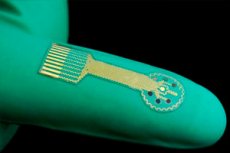New publications
New 'smart dressings' could dramatically improve chronic wound management
Last reviewed: 02.07.2025

All iLive content is medically reviewed or fact checked to ensure as much factual accuracy as possible.
We have strict sourcing guidelines and only link to reputable media sites, academic research institutions and, whenever possible, medically peer reviewed studies. Note that the numbers in parentheses ([1], [2], etc.) are clickable links to these studies.
If you feel that any of our content is inaccurate, out-of-date, or otherwise questionable, please select it and press Ctrl + Enter.

Chronic wounds, such as diabetic ulcers, surgical wounds, and pressure ulcers, pose a serious health threat. Patients with chronic wounds have a five-year survival rate of about 70%, worse than patients with breast or prostate cancer. Wound treatment is also expensive, costing the United States about $28 billion annually.
A team of researchers from the Keck School of Medicine of the University of Southern California (USC) and the California Institute of Technology (Caltech) is developing cutting-edge technologies to revolutionize wound care, including smart dressings that automatically respond to changes in a wound’s condition. These high-tech dressings provide continuous data on healing and potential complications, such as infections or abnormal inflammation, and can deliver medications in real time.
The USC-Caltech team developed and tested smart bandages in animal models in a proof-of-concept study. They published a review of this research and other modern wound monitoring and treatment methods in the journal Nature Materials.
Smart dressings can not only monitor the wound, but also actively participate in the healing process. Instead of passively applying a dressing, doctors can use wireless technology to detect inflammation, infection, or blood flow problems, and notify patients and healthcare providers via Bluetooth, providing real-time treatment.
Smart dressings are made from a variety of advanced materials, including bioelectronic materials that can promote healing by electrically stimulating tissue and cells. Many contain hydrogels, which are soft, flexible, and capable of storing and releasing drugs in response to changes in pH, temperature, or other environmental factors.
Smart dressings contain different types of sensors to detect changes in the wound microenvironment. Electrochemical sensors can measure the presence of proteins, antibodies, nutrients, and electrolytes, while optical sensors can monitor temperature, pH, and oxygen levels.
There are several hurdles to overcome before smart dressings can be integrated into standard medical practice. In particular, many medical systems rely on outdated wound care practices. Integrating smart dressings will require significant changes to current standards.
The process of getting approval from the U.S. Food and Drug Administration (FDA) is also complex. To get specific approval, researchers must collect a large amount of preclinical and clinical data. That is the current goal of the USC-Caltech research team.
Smart dressings represent a powerful strategy for improving wound care and could significantly improve the quality of life of patients with chronic wounds. Next, the researchers plan to explore a new approach to wound care using ultrasound technology to deliver gene therapy. The goal is to stimulate the growth of blood vessels in the calf muscles, which could help reduce the risk of amputation in patients with leg ulcers.
